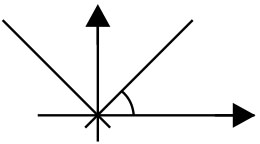Equations of the Bisectors of the Angles between Two Straight Lines
An angle bisector is a line that evenly divides the angle between two intersecting lines into two equal angles. This bisector represents the locus of all points that are equidistant from both lines. In other words, an angle bisector maintains an equal perpendicular distance from each of the two intersecting lines.
JEE Main 2025: Sample Papers | Mock Tests | PYQs | Study Plan 100 Days
JEE Main 2025: Maths Formulas | Study Materials
JEE Main 2025: Syllabus | Preparation Guide | High Scoring Topics
- What is an Angle bisector?
- Derivation of Equation of the Bisectors
- Distinguish between obtuse and acute angle bisector
- Shortcut Method for Identifying Acute Obtuse Angle Bisectors
- Solved Examples Based on Equation of the Bisectors
.png)
In this article, we will cover the concept of Equation of the Bisectors. This category falls under the broader category of Coordinate Geometry, which is a crucial Chapter in class 11 Mathematics. It is not only essential for board exams but also for competitive exams like the Joint Entrance Examination(JEE Main) and other entrance exams such as SRMJEE, BITSAT, WBJEE, BCECE, and more. A total of nineteen questions have been asked on JEE MAINS( 2013 to 2023) from this topic.
What is an Angle bisector?
The Locus of point which is equidistant from both lines is called the angle bisector. The bisector is the locus of a point that moves in the plane of lines
Equation of the Bisectors
The equation of the angle bisectors between the two lines
Derivation of Equation of the Bisectors

Given equations of lines
RR' and SS' are two bisectors of the angle between the line
Bisector of the Angle Containing the Origin
Rewrite the equation of the line
Then, the equation
gives the equation of the bisector of the angle containing the origin and
gives the equation of the bisector of the angle not containing the origin.
Distinguish between obtuse and acute angle bisector

Let,
where,
Equation of bisectors are
To distinguish between acute angles and obtuse angle bisectors, choose one of the equations of bisector, say eq (iii). Let the angle between this bisector and one of the given lines be
Similarly, ROB is the bisector of an obtuse angle if,
Shortcut Method for Identifying Acute Obtuse Angle Bisectors
The equation of two non-parallel lines are
Then equation of bisectors are
Recommended Video Based on Equation of the Bisector
Solved Examples Based on Equation of the Bisectors
Example 1: The sides of a rhombus
Solution: Let co-ordinate of
The equation of parallel lines are
Diagonals are parallel to angle bisectors, i.e.
i.e.
Slope of
Hence, the answer is
Example 2: If one of the lines of
Solution:

So the slope of the line equally inclined is:
Hence, the answer is 1.
Example 3: The perpendicular bisector of the line segment joining
Solution:

Mid-point of
Slope of
The slope of a line perpendicular to
Hence, the required answer is 4
Example 4: P is a point on either of the two lines
Solution: The distance between the point

distance of
Hence, the required answer is
Example 5: The equation of the bisector of the angle between the lines
Solution: Equation of bisector:
Now at
Hence the equation of bisector contains the point
Hence, the answer is
Frequently Asked Questions (FAQs)
The Locus of point which is equidistant from both lines is called the angle bisector. The bisector is the locus of a point that moves in the plane of lines
The equation of the angle bisectors between the two lines
The equation of the angle bisectors between the two lines
Let the angle between this bisector and one of the given lines be
Let the angle between this bisector and one of the given lines be
Also Read
15 Feb'25 02:23 AM
15 Feb'25 02:19 AM
15 Feb'25 02:17 AM
15 Feb'25 02:04 AM
15 Feb'25 02:02 AM
15 Feb'25 01:55 AM
15 Feb'25 01:51 AM
15 Feb'25 01:47 AM
15 Feb'25 01:44 AM
15 Feb'25 01:44 AM

